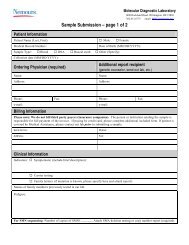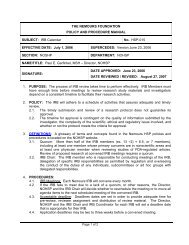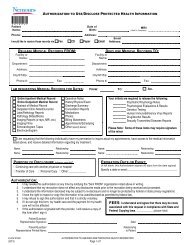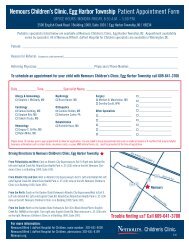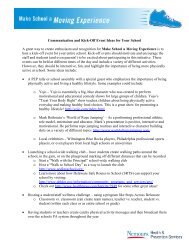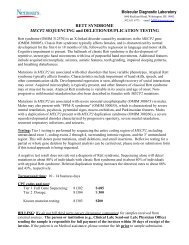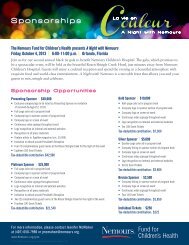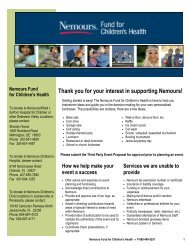Best Practices for Healthy Eating Guide - Nemours
Best Practices for Healthy Eating Guide - Nemours
Best Practices for Healthy Eating Guide - Nemours
You also want an ePaper? Increase the reach of your titles
YUMPU automatically turns print PDFs into web optimized ePapers that Google loves.
Children 1 through 2 Years:<br />
Grains & Breads<br />
Recommended Limit Not Recommended<br />
n Make half of grain servings whole<br />
grains*<br />
n Grain foods that have more than 3<br />
grams of fiber per serving, as labeled<br />
n Foods should have zero grams of<br />
trans fat<br />
n Whole grain pasta<br />
n Whole grain bread<br />
n Whole grain cereal<br />
n Brown rice<br />
n Oatmeal<br />
n Bulgur<br />
n Quinoa<br />
n Added fat, sugar or salt n Cereals or grains with more than 6<br />
grams of sugar per serving, as labeled<br />
n Sweet grains (cakes, cupcakes,<br />
donuts, Danishes, cinnamon rolls,<br />
toaster pastries, granola bars, cookies,<br />
commercially-prepared muffins, etc.)<br />
*To determine if a product is a whole grain, look on the ingredients list. A whole grain should be the first ingredient listed, or the first ingredient<br />
after water. Examples include whole wheat flour (not just “wheat flour”), whole grain corn, whole cornmeal, brown rice, oats or whole oats, etc.<br />
Rationale<br />
Why serve whole grains<br />
n The Dietary <strong>Guide</strong>lines <strong>for</strong> Americans recommend<br />
making half of grain servings whole grains.<br />
n Whole grains are good sources of dietary fiber, several<br />
B vitamins and minerals.<br />
n Children and adults should eat about 14g of fiber <strong>for</strong><br />
every 1,000 calories consumed. Diets high in fiber<br />
have a number of beneficial effects, including lowering<br />
the risk <strong>for</strong> heart disease and preventing constipation.<br />
n Choosing foods that are free of added sugars helps<br />
people meet their nutrient needs without eating too<br />
many calories, sugars and fats.<br />
n Added sugars supply calories but few or no nutrients.<br />
n Discretionary calorie allowance <strong>for</strong> children 2 – 5<br />
years of age allows <strong>for</strong> only 4 – 5 tsp of added sugars<br />
each day.<br />
n Limiting cereals to 6g of sugar (1.5 tsp) or fewer will<br />
help to keep added sugars low in children’s diets.<br />
Portion Size<br />
Item Meals Snacks<br />
Bread items (bread, rolls, bagels, etc.) ½ slice ½ slice<br />
Cereals, hot or cold ¼ cup (2 oz.) ¼ cup (2 oz.)<br />
Pasta, noodles or grains ¼ cup (2 oz.) ¼ cup (2 oz.)<br />
<strong>Best</strong> <strong>Practices</strong> <strong>for</strong> <strong>Healthy</strong> <strong>Eating</strong> 19



